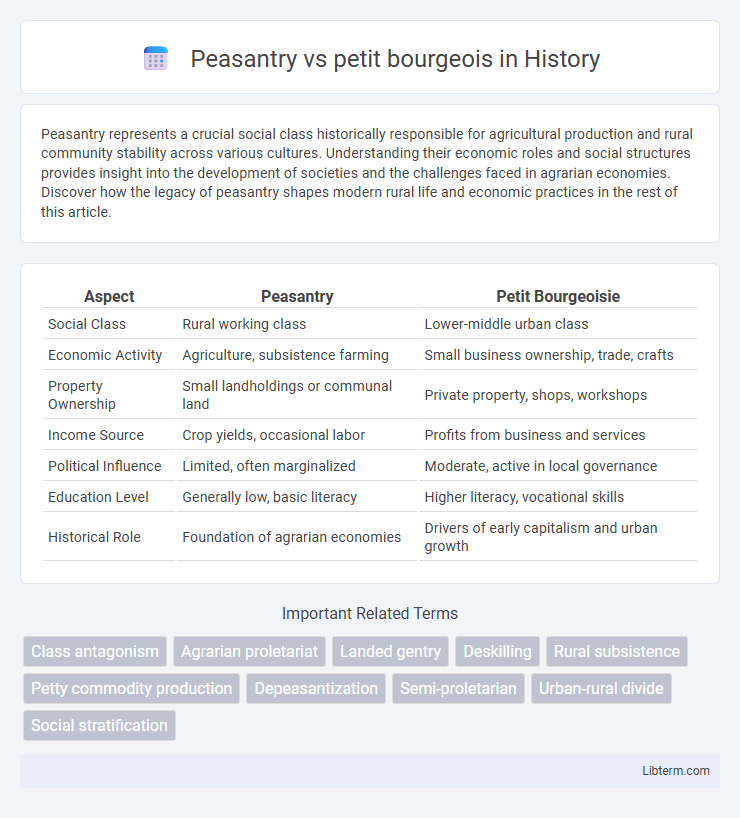Peasantry represents a crucial social class historically responsible for agricultural production and rural community stability across various cultures. Understanding their economic roles and social structures provides insight into the development of societies and the challenges faced in agrarian economies. Discover how the legacy of peasantry shapes modern rural life and economic practices in the rest of this article.
Table of Comparison
| Aspect | Peasantry | Petit Bourgeoisie |
|---|---|---|
| Social Class | Rural working class | Lower-middle urban class |
| Economic Activity | Agriculture, subsistence farming | Small business ownership, trade, crafts |
| Property Ownership | Small landholdings or communal land | Private property, shops, workshops |
| Income Source | Crop yields, occasional labor | Profits from business and services |
| Political Influence | Limited, often marginalized | Moderate, active in local governance |
| Education Level | Generally low, basic literacy | Higher literacy, vocational skills |
| Historical Role | Foundation of agrarian economies | Drivers of early capitalism and urban growth |
Defining Peasantry and Petit Bourgeois
Peasantry refers to a social class primarily engaged in small-scale agriculture, characterized by subsistence farming and limited access to capital or markets, often maintaining traditional lifestyles and communal land tenure systems. Petit bourgeois denotes a lower-middle-class group comprising small business owners, artisans, or independent professionals who possess some capital and seek economic mobility through entrepreneurship and market participation. The fundamental distinction lies in economic roles and social relations: peasants rely on direct cultivation of land with minimal market integration, while the petit bourgeois operates within capitalist market structures aiming for profit and social status enhancement.
Historical Origins and Evolution
The peasantry, historically rooted in feudal agrarian systems, primarily consisted of rural agricultural laborers tied to landownership structures dating back to medieval Europe. The petit bourgeois emerged during the early modern period as a class of small property owners, merchants, and artisans distinct from both the aristocracy and the working class, evolving alongside urbanization and capitalist market expansion. Over time, the peasantry's decline due to industrialization contrasted with the petit bourgeoisie's growth, reflecting broader socio-economic transformations from feudalism to capitalism.
Economic Roles and Class Functions
Peasantry primarily engages in subsistence agriculture with limited market exchange, sustaining rural economies through labor-intensive farming and small-scale production. The petit bourgeois class operates small businesses or owns workshops, functioning as intermediaries between the proletariat and bourgeoisie by controlling modest capital and means of production. Economically, peasantry maintains traditional agrarian output, while the petit bourgeoisie drives localized commerce and crafts, influencing urban and rural market dynamics.
Modes of Production and Labor
The peasantry primarily engages in subsistence agriculture within a feudal or semi-feudal mode of production, relying on household labor and limited market integration. In contrast, the petit bourgeoisie operates within a capitalist mode of production, owning small-scale businesses or means of production and employing wage labor or self-labor. These differences shape class dynamics, with peasants focusing on survival through land cultivation and petit bourgeoisie aiming for profit through production and trade.
Land Ownership vs. Small Enterprise
Peasantry primarily relies on land ownership for subsistence and economic activity, often engaging in agriculture on family-owned plots, which limits capital accumulation but ensures direct control over production. In contrast, the petit bourgeois class operates small enterprises or shops, emphasizing market transactions and capital investment rather than land possession, allowing for more flexible economic mobility. The distinct property bases--land for peasants and business assets for petit bourgeois--shape their social roles, economic strategies, and class interests.
Social Status and Cultural Identity
The peasantry is traditionally associated with rural agricultural labor, characterized by lower social status and a collective cultural identity rooted in local customs and communal practices. In contrast, the petit bourgeoisie occupies a middle social status, often comprising small business owners or skilled tradespeople, who embrace a cultural identity linked to individualism, economic self-sufficiency, and aspirations for upward mobility. This distinction highlights the peasantry's connection to land-based traditions versus the petit bourgeoisie's alignment with emerging capitalist values and urban lifestyles.
Political Alignments and Influence
Peasantry historically aligned with agrarian populism and leftist movements advocating land reforms and social equity, while the petit bourgeois consistently supported conservative or centrist parties emphasizing small business interests and private property rights. The political influence of the peasantry often manifested in mass mobilizations and rural voting blocs, challenging elite dominance, whereas the petit bourgeois exerted influence through local commerce networks and participation in urban governance. Both classes shaped policy debates on taxation, labor laws, and economic modernization, reflecting their distinct socioeconomic positions and priorities.
Urban-Rural Divide
The urban-rural divide shapes the socio-economic distinctions between the peasantry and the petit bourgeois, where peasants typically engage in agriculture and rural subsistence, while the petit bourgeois operate small businesses and trades in urban centers. This divide influences access to resources, market integration, and social mobility, with the peasantry often experiencing limited economic diversification compared to the more market-oriented petit bourgeoisie. Rural-urban dynamics also affect political affiliations and cultural identities, reinforcing structural disparities in wealth and opportunity between these social classes.
Transformations in Modern Societies
Peasantry and petit bourgeois classes experienced profound transformations in modern societies marked by industrialization and urbanization. The peasantry gradually shifted from subsistence agriculture to wage labor or diversified rural economies, while the petit bourgeoisie expanded through small-scale commerce and service industries, adapting to capitalist market demands. These changes redefined social hierarchies, economic roles, and cultural identities within emerging capitalist structures.
Relevance in Contemporary Class Analysis
The distinction between peasantry and petit bourgeois remains relevant in contemporary class analysis as it highlights varying modes of production and social relations within rural and urban settings. Peasantry typically involves subsistence farming and communal ties, while the petit bourgeoisie operates small-scale enterprises with market dependency. Understanding these categories aids in analyzing economic behavior, class mobility, and the impact of globalization on traditional and emerging social classes.
Peasantry Infographic

 libterm.com
libterm.com